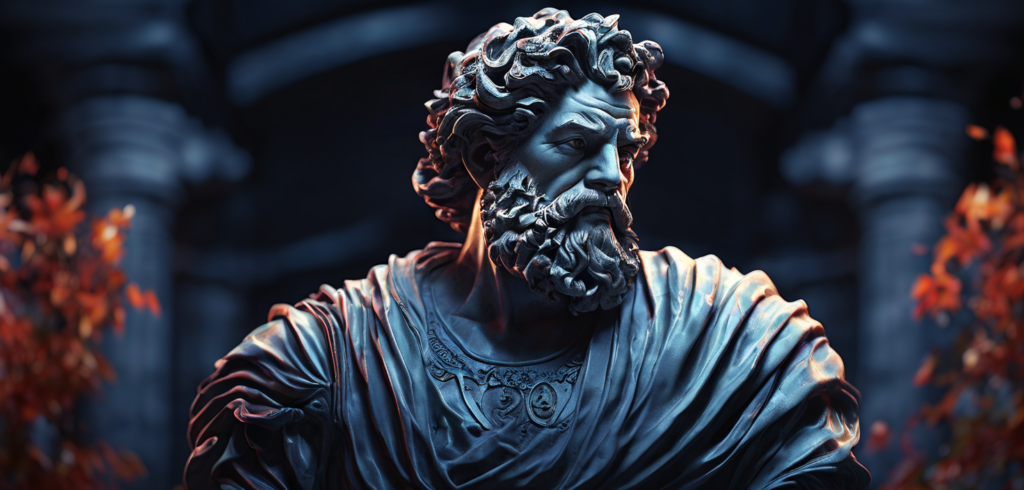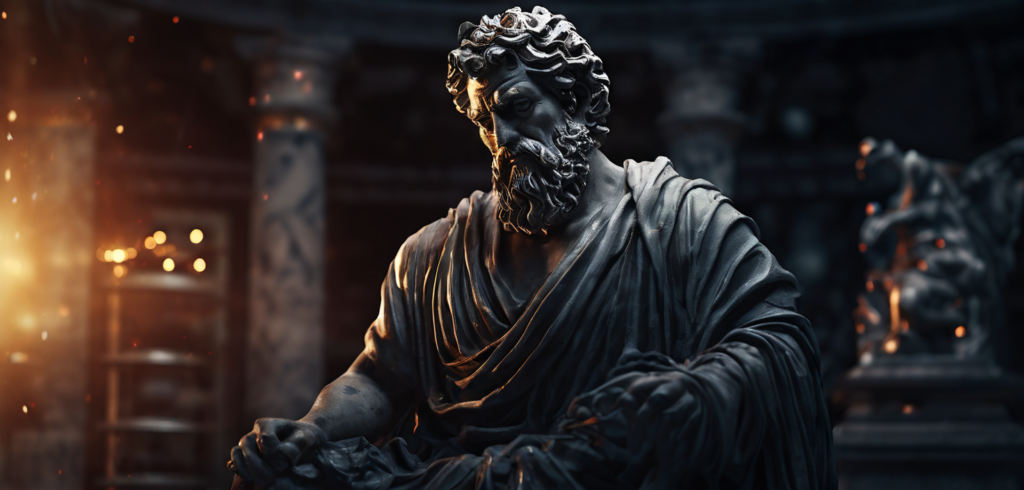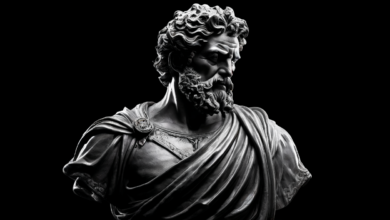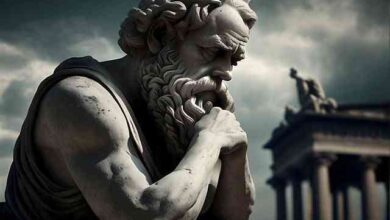Stoic Resilience Ancient Wisdom for Modern Challenges
Introduction
In a world full of uncertainty and challenges, resilience becomes an essential quality to navigate through life’s storms. “Stoic Resilience: Ancient Wisdom for Modern Challenges” is a narrative that delves deep into the principles of Stoicism, offering a practical approach to facing adversity with wisdom and equanimity. This story, rich in philosophical insights and human examples, invites readers to discover how the teachings of philosophers such as Seneca, Epictetus, and Marcus Aurelius can be applied in everyday life to build a strong mind and an unshakable spirit.

Encountering Adversity
Carlos had always considered himself a lucky man. At 40, he had built a solid career as an executive in a multinational company, owned a comfortable home in the suburbs of the city, and enjoyed an active social life. However, this sense of security began to crumble when the company he worked for announced a restructuring. Amid cuts and layoffs, Carlos suddenly found himself unemployed, a reality he had never considered.
The news came as a bombshell. The ground seemed to have dropped away from beneath his feet. What had once been routine—meetings, business trips, important decisions—was now replaced by empty days and a growing sense of futility. Uncertainty about the future consumed him, and with each passing day, his self-confidence diminished.
To make matters worse, his wife, Maria, began to show signs of dissatisfaction in their marriage. Their conversations became strained, and the distance between them grew. Carlos felt lost, not knowing how to reconnect with the woman he loved. Life, which had once seemed so predictable and controlled, was now a maze of problems with no apparent solution.
One rainy afternoon, while tidying up the attic, Carlos found an old box with his grandfather’s things. Among the black-and-white photographs and yellowed letters, there was a leather-bound book with Greek inscriptions. Curious, he opened the book and read the first page: “Meditations” by Marcus Aurelius. He remembered how his grandfather had always talked about philosophy and how it had helped him face life’s challenges. He decided then that he would read the book. Perhaps, he thought, he could find some guidance, some comfort in the words of a Roman emperor who had lived almost two thousand years ago. That night, he began to read. Marcus Aurelius’s words resonated deeply within him, as if they had been written for his current situation.

The Wisdom of Seneca – Accepting the Inevitable
Charles immersed himself in the works of Seneca, a Stoic philosopher who lived in the first century A.D. Seneca taught about accepting adversity as an inevitable part of life. He argued that by accepting what we cannot change, we can focus our energy on actions that are within our reach.
Charles pondered this idea. He realized that he had been resisting his new reality, trying to deny what had happened. But by accepting his situation, he felt calmer. He began to focus on what he could control: updating his resume, seeking new job opportunities, investing in his professional development.
Seneca also talked about the importance of not letting external circumstances get the better of him. Carlos remembered that his identity was not tied solely to his job. He was more than just an executive; he was a husband, a friend, a human being with skills and talents that went beyond the office.
This new perspective brought him a sense of relief. Carlos felt lighter, freer. He began to see his situation not as a failure, but as an opportunity to grow and reinvent himself.
Epictetus and the Power of Perception
Carlos continued his journey of self-discovery, now guided by the words of Epictetus. The philosopher taught that happiness lies not in external circumstances, but in the way we perceive and react to them. Charles began to understand that he had the power to control his perceptions and, consequently, his happiness. He began to practice mindfulness, focusing on the present and observing his reactions to the events around him. Charles realized that he often overreacted to situations that, in retrospect, were not as serious as they seemed. He learned to control his emotions and respond more rationally. Epictetus also taught about the distinction between what we can and cannot control. Carlos thought about this idea and realized that many of his worries were about things he couldn’t change.He decided that he would focus his energy on the things he could control and accept the things he couldn’t.
This new approach brought him an inner peace he didn’t know was possible.Carlos felt freer, happier.He realized that happiness was not a matter of circumstances, but of perception. Happiness was the ability to see the bright side of things, to accept reality and to respond in a positive way.

Marcus Aurelius and Inner Discipline
As Charles read on, Marcus Aurelius’s words resonated deeply with him. Inner discipline, the pursuit of personal excellence, and the building of strong character were themes that resonated with his own aspirations. Charles realized that in order to live by Stoic principles, he needed to cultivate self-discipline.
He began to establish healthy routines. He woke up early to meditate and exercise. He organized his day with to-do lists and set clear goals. The discipline he applied to his daily life was reflected in his work. Carlos became more productive and efficient, and his colleagues noticed his change in attitude.
Self-discipline also manifested itself in his eating and sleeping habits. Carlos began to take better care of himself, recognizing that a healthy body was essential to a healthy mind. He discovered that discipline was not a restriction, but a liberation. By controlling his impulses, he felt freer to focus on what really mattered.
Marcus Aurelius taught that discipline was an art form, an ongoing practice of self-improvement. Charles embraced this view, seeing each day as an opportunity to grow and improve. He felt more confident and fulfilled, knowing that he was in control of his own life.
The Art of Resilience
Charles began to apply Stoic principles to his daily life. He learned the art of resilience, developing the ability to bounce back quickly from setbacks. Carlos discovered that resilience is not just about withstanding suffering, but also about finding hope and meaning in the midst of adversity.
He learned to accept adversity as a part of life.Rather than resisting suffering, he embraced it as an opportunity for growth. Carlos discovered that by facing his challenges with courage and determination, he could turn them into sources of strength and wisdom.
The resilience that Carlos developed allowed him to overcome obstacles and emerge stronger. He realized that adversity was an inevitable part of life, but that it did not have to define him. Resilience was a choice, a way of living that could be cultivated and practiced.
Carlos also learned to appreciate the little things, to appreciate the moments of joy and beauty that still existed in his life. He discovered that resilience was not just about enduring suffering, but also about finding hope and meaning in the midst of adversity.

Community and a Sense of Purpose
Carlos realized that true resilience was also linked to connecting with others and finding a sense of purpose. He began to get involved in community activities, finding strength and inspiration in service to others. This chapter explores how community can be a source of support and motivation on the journey to resilience.
He discovered that true happiness was also linked to service to others and contributing to the community. Carlos began volunteering, helping those who were in vulnerable situations.This experience enriched his life in ways he had not expected.
Carlos felt more connected and fulfilled.He realized that by helping others, he was also helping himself.The community became a source of inspiration and purpose.Carlos discovered that a sense of purpose was an essential part of a fulfilling life.
He also realized that community was an important part of Stoic philosophy. The Stoics believed that we were all part of a global community, and that we had a duty to contribute to the common good. Charles was inspired by this insight, and decided that he would live by these principles.
As Charles applied Stoic principles to his life, he realized that community was an essential part of a fulfilling life. He discovered that by connecting with others and working together toward a common goal, he could find a sense of purpose that went beyond himself.This connection with community brought him a new dimension of meaning and fulfillment.
Virtue as a Pillar of Resilience
Virtue is presented as a fundamental pillar of resilience. Carlos learns that acting with integrity, fairness, courage, and wisdom not only strengthens his character but also prepares him to face challenges with a clear mind and a firm heart. This chapter highlights the importance of virtue in building a resilient life.
He began to practice virtue in his daily life. At work, he strived to be fair and honest in his interactions. With friends and family, he became more compassionate and empathetic. Charles also worked to develop his courage by facing his fears and taking calculated risks.
As Charles lived his life according to virtue, he felt more fulfilled and happier. The happiness he experienced was not a superficial happiness, but a deep and lasting satisfaction. He realized that virtue was the foundation of a fulfilling and meaningful life.
Charles also noticed that virtue strengthened his relationships. The people around him felt closer and more appreciated. Virtue was contagious, and Charles found himself inspiring others to live more virtuously.
Accepting Impermanence
Charles faced the reality of impermanence and learned to accept change as an inevitable part of life. He realized that much of his distress stemmed from fear of change and uncertainty about the future. Charles decided he would embrace change as an opportunity for growth.
He began to practice acceptance, following the teachings of the Stoic philosophers about the importance of accepting reality.Carlos realized that by accepting the things he could not change, he could focus his energy on the things he could.This new approach brought him an inner peace he didn’t know was possible.
Carlos also learned to appreciate the present, to value each moment as unique and precious.He realized that life is made up of moments, and that each of them is a gift. This awareness gave him a new perspective, a different way of seeing the world.
Accepting impermanence did not mean resignation or apathy. On the contrary, Carlos felt more motivated to live life to the fullest, to seize every opportunity. He discovered that by accepting change, he could face challenges with greater resilience and courage.

Personal Legacy and the Art of Living
In the final chapter, Carlos reflects on his journey and the legacy he wants to leave. He realizes that the art of living is not a destination, but an ongoing process of learning and growth. Carlos decides that he wants to live by Stoic principles, leaving a legacy of resilience and wisdom for future generations.
He reflects on the lessons he has learned from the Stoics and how they have transformed his life. Carlos feels grateful for having encountered this philosophy and for having had the courage to apply it in his daily life.He knows that the journey does not end here, but that it is only the beginning of a new phase.
Carlos decides that he wants to leave a positive legacy that inspires others to seek wisdom and virtue.He wants to share his story and his experiences, in the hope that they can help others on their own journey. Carlos believes that everyone has the potential to live a full and meaningful life, and that Stoic philosophy can be a powerful tool to achieve this goal.
He begins writing a book, sharing his reflections and insights on the art of living.Carlos hopes that his book can serve as a guide for those seeking a more balanced, meaningful and resilient life.He continues to believe that by sharing his journey, he can help others find their own path.
Carlos also decides to continue to participate in the community, to contribute to the common good, and to live according to Stoic principles.He knows that the art of living is an ongoing practice, and that each day is an opportunity to grow and improve.
Conclusion
“Stoic Resilience: Ancient Wisdom for Modern Challenges” culminates with Carlos transformed, not only in his outlook, but in his way of living. He becomes a living example of how Stoic principles can be applied to build a resilient and meaningful life.The story ends on a note of hope, encouraging readers to embark on their own journey of self-discovery and wisdom.
Carlos realizes that the art of living is an ongoing journey, a lifelong search for wisdom and virtue.He is grateful for having encountered this philosophy and for having had the courage to apply it to his daily life. Carlos knows he still has much to learn, but he is confident that he is on the right path.
Carlos’s story is a testament to the transformative power of Stoic philosophy.It is a story of self-discovery, growth, and personal fulfillment.It is a story that inspires hope and encourages readers to seek wisdom and virtue in their own lives.
Tags: adversity, legacy, purpose, resilience, self-discovery, stoicism, wisdom
The Journey Continues
As time passed, Charles felt that his Stoic journey had not only transformed him internally, but had also driven him to leave a positive mark on the world. He realized that the art of living was not a final destination, but an ongoing process of learning and growth. Each day presented new opportunities to practice virtue, to exercise wisdom, and to contribute to the well-being of others.
Carlos decided he wanted to share his journey and the lessons he had learned with a wider audience. He began writing a book, not just as a personal account, but as a guide for those who, like him, were seeking a more meaningful and happy life. The book, titled “Stoic Resilience: Ancient Wisdom for Modern Challenges,” became a synthesis of his experience and the Stoic teachings that had so influenced him.
In the process of writing, Carlos reflected deeply on his legacy. He wanted his work to inspire others to seek true happiness not through the accumulation of material possessions or social recognition, but through personal development and community connection. Carlos believed that by sharing his story, he could help others find their own path to personal fulfillment.
In addition to writing, Carlos also began giving lectures and workshops on stoicism and resilience. He traveled to different cities, sharing his ideas and listening to other people’s stories. These experiences enriched his understanding of the human condition and reinforced his belief in the universality of Stoic principles.
Carlos also continued to practice virtue in his daily life. He became involved in community projects, volunteered at local shelters, and participated in environmental sustainability initiatives. Through these actions, Charles felt that he was living according to Stoic principles, contributing to the common good and finding a sense of purpose that went beyond himself.
However, Charles knew that the journey did not end here.He recognized that there was still much to learn and that the search for wisdom was a never-ending path.But this realization did not discourage him;on the contrary, it filled him with enthusiasm and hope. Charles was grateful to have found a philosophy that not only helped him overcome his personal challenges, but also offered him a path to a full and meaningful life.
Final Conclusion
“Stoic Resilience: Ancient Wisdom for Modern Challenges” ends with Charles in a state of contentment and fulfillment.He not only transformed his own life, but also inspired others to pursue wisdom and virtue. Carlos’s story is a testament to the transformative power of Stoic philosophy and how it can be applied to modern life to foster resilience and well-being.
The narrative ends on a note of hope, encouraging readers to embark on their own journey of self-discovery. Carlos reminds us that resilience is not a final destination, but a state of mind that can be cultivated through the constant practice of virtue, the acceptance of impermanence, and the pursuit of wisdom.
Tags: adversity, legacy, purpose, resilience, self-discovery, stoicism, wisdom



